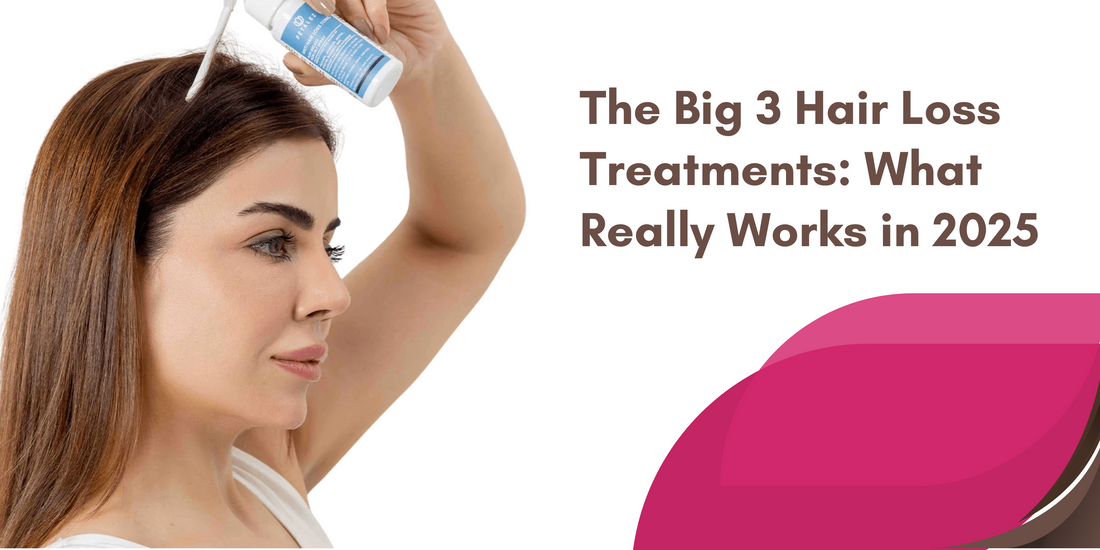
The Big 3 Hair Loss Treatments: What Really Works in 2025
Share
Hair loss is a common concern affecting millions of people globally, regardless of age or gender. It can impact confidence and quality of life, but thanks to medical advances, treatment options in 2025 are more effective and accessible than ever. Among the various choices available, three remain the most trusted and widely used: Minoxidil, Finasteride, and Hair Transplant Surgery. This guide breaks down how each works, what results to expect, and how to choose the right solution for your needs.
Understanding Hair Loss: Causes and Types
Common Causes
Hair loss can result from a variety of factors:
- Genetics – The most common cause, especially for pattern baldness.
- Hormonal changes – Pregnancy, menopause, or thyroid issues can trigger shedding.
- Lifestyle factors – Poor diet, high stress, and lack of sleep all contribute.
- Medications and illnesses – Certain drugs or medical conditions can lead to hair thinning.
Common Types
- Androgenetic Alopecia – Male and female pattern baldness (receding hairlines or thinning crowns).
- Telogen Effluvium – Sudden, temporary shedding often caused by stress or illness.
- Alopecia Areata – Patchy bald spots due to an autoimmune response.
- Traction Alopecia – Caused by hairstyles that pull on the scalp.
The Big 3 Hair Loss Treatments in 2025
1. Minoxidil – Topical Growth Booster
Originally developed for blood pressure, Minoxidil is now a top over-the-counter hair growth treatment. Available in foam or liquid (up to 5% strength), it improves blood flow to hair follicles and extends the growth phase.
What’s New in 2025:
Modern formulas absorb faster and cause less irritation. Some even include ingredients like caffeine or peptides for added effect.
Effectiveness:
- 40–60% of users report visible improvement in 6 months
- Best for early-stage thinning
- Requires consistent, long-term use
Side Effects:
Possible scalp irritation or unwanted hair growth near the face. Consistency is key—missed doses can reduce results.
2. Finasteride – Hormone Blocker Pill
Finasteride works by lowering DHT levels—a hormone that shrinks hair follicles. It’s a prescription medication primarily used for male pattern baldness.
What’s New in 2025:
Dosing has become more personalized, and topical Finasteride options are also gaining popularity to reduce side effects.
Effectiveness:
- Slows or stops hair loss in most men
- Some users experience regrowth in thinning areas.
- Best combined with Minoxidil or PRP for enhanced results
Side Effects:
May include low libido or mild erectile issues (affects a small percentage). Not recommended for women who are pregnant or trying to conceive.
3. Hair Transplant Surgery – Permanent Hair Restoration
Surgical hair transplants move healthy follicles from donor areas (usually the back of the scalp) to balding zones.
Techniques in 2025:
- FUE (Follicular Unit Extraction) – Less scarring, quicker healing
- FUT (Follicular Unit Transplant) – More grafts in one session
- Robotic-assisted transplants – Precision and improved survival rates
Recovery:
Downtime is minimal (3–10 days). Post-op care includes gentle washing and avoiding strenuous activities.
Results:
Most patients see full results within 9–12 months. Natural-looking and permanent when done by an experienced surgeon.
Advantages & Disadvantages
Additional Treatments and Emerging Innovations
Low-Level Laser Therapy (LLLT)
LLLT devices—like laser caps or combs—stimulate follicle activity with light energy. In 2025, these tools will be more powerful and FDA-cleared for home use. Regular use (3–4 times per week) may increase density and hair strength.
Platelet-Rich Plasma (PRP) Therapy
PRP involves drawing your blood, extracting growth factors, and injecting them into the scalp. It improves follicle health and promotes regrowth. Modern techniques yield up to 70% success rates when paired with other treatments.
Emerging Trends
- Stem cell therapies to regenerate damaged follicles
- Gene editing to address hereditary hair loss
- Scalp micro pigmentation (SMP) for a denser appearance
These are still under research, but early results are promising.
What Works Best? A 2025 Comparison
| Treatment | Ideal For | Maintenance | Speed of Results | Long-Term Outcome |
|---|---|---|---|---|
| Minoxidil | Early-stage thinning | Daily | 3–6 months | Good, with use |
| Finasteride | Hormone-related loss | Daily | 3–6 months | Great, if tolerated |
| Hair Transplant | Advanced baldness | Low | 6–12 months | Permanent |
Expert Advice and Real-World Examples
Dermatologists emphasize starting early. One doctor shared that combining Finasteride + Minoxidil + PRP gave a patient near-complete recovery from moderate baldness in under a year.
Other case studies show high satisfaction rates with multi-modal plans tailored by trichologists and cosmetic surgeons.
How to Choose the Right Hair Loss Treatment
- Consult a dermatologist or trichologist
- Identify your hair loss type and stage
- Set realistic expectations
- Stay consistent—results take time
- Support your scalp with good nutrition and gentle care
Choosing the Right Path
- Diagnose your hair loss type early
- Talk to a certified dermatologist or hair specialist
- Start with non-invasive treatments first
- Add supportive products like Petalez Hair Growth Serum
- Stick to your routine—hair regrowth takes time
Conclusion: Take Control of Hair Loss in 2025
In 2025, Minoxidil, Finasteride, and Hair Transplant Surgery remain the most effective and trusted treatments for hair loss. Innovations continue to improve outcomes, and when used correctly, these options can restore not just your hair—but your confidence too.
The best results come from combining science-backed treatments with consistency and expert advice. Start early, stay informed, and take charge of your hair health today.
FAQs – Hair Loss & Petalez Serum
1. Can I use Petalez with Minoxidil or Finasteride?
Yes, it’s safe and enhances results when combined.
2. When will I see results with Petalez?
Most users notice improvement in 2–3 months.
3. Is Petalez for men and women?
Yes, it’s suitable for all genders and hair types.
4. Is a hair transplant permanent?
Yes, though maintenance treatments may still be needed.
5. Can I use Petalez after a transplant?
Yes, once the scalp has healed.
6. Do I need a prescription for Petalez?
No, it’s an over-the-counter natural product.
7. Are natural treatments like Petalez effective?
Yes, especially for early-stage hair loss or as a support treatment.


